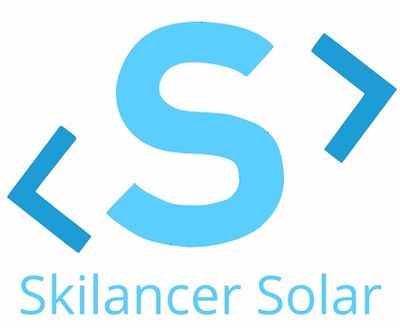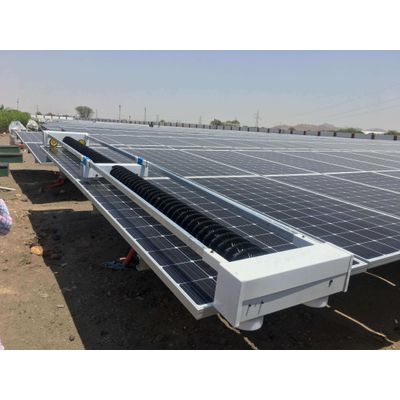

- Home
- Companies
- Skilancer Solar
- Products
- Skilancer - Fully Automated PV Panel ...

Skilancer - Fully Automated PV Panel Cleaning Device
Fully-automated cleaning devices are installed on each row of a PV system and are stored at a parking station at one side of each row. They are programmed to move along a single module row only. Most of the devices have an error detection system and take weather conditions in consideration before they operate. All fully-automated products operate with an on-board battery, although some devices may be additionally charged by their own PV modules. Fully automated devices may have an additional railsystem installed; obstructions between tables (space, steps and tilt) must be taken into account. As the name implies, fully automated devices do not require any manual labour for the cleaning process or for the positioning of the devices. Fully-auto- mated devices can also operate during the night.
Design:
The design of the device was a rolling brush that traverses along an array of solar panels. The device would attach to the array using rollers that grip the frame of the panels and use them as rails to roll along the panel. The system cleans the panel using a spinning brush to clear any dust or debris. Ideally, the device would not use water and would not need to be connected to any source of water.
Functional Analysis:
We devised a system that moves along the length of an array of panels, cleaning the entire array. This design was selected primarily for its simplicity. Its component subsystems have been observed to function well in other applications. The device moves across a row of panels and cleans using a spinning array of brushes. The system will move using soft rubber wheels driven by an electric motor. The rotating brush system will be mounted on a rotating axle which is also spun by the main drive motor. Using a single motor is advantageous for both cost and simplicity. However, the drive motor will need to deliver high torque in order to function effectively. To reduce the stress on both the system and the panel surface, a series of lighter cleaning cycles will be used rather than a single more intense cleaning. This device will run across a row of panels and back to its original position. The device will be powered by an internal battery. At the end of each cleaning cycle, the system will return to a docking station at the end of the panel where it will recharge the battery. The dock system will act as an extended platform next to the panels to allow the system to move off the panel surface, so it does not obstruct sunlight from any part of the panel.The system uses a motorized brush to clean the surface of the panel array. The system is moved along the panel by two sets of motorized wheels, with one set located at either end of the device. The entire system is driven by a compact high-torque DC motor. The entire system is controlled by anonboard microcontroller which is paired with a dedicated motor controller. This control system is able to fully automate the system’s cleaning process with the ability to schedule cleanings at any given time.
Salient features of the robots:
- Artificially Intelligent
- Safe & Reliable
- Internet Connected
- Energy Independent Operation
- No Water Required
- Autonomous
- Daily Cleaning of PV Modules
Dimensions
Length: 1-6 mtr
Width: 500 mm
Height: 400 mm
Weight: 15-25 Kg
Command/Control Characteristics
Logic: Independent operation
Comms 1: LoRa wireless
Comms 2: SCADA integration
Program: Fully programmable cycle
Power Characteristics
Supply: 10-20W solar panel
Storage: 20Ah/14.8V Li-ion battery
Control: Charge controller
Mounting System Characteristics
Retrofit: Bracket mounted rail
Integrated: Rail/Support integrated
Panel Overhang: < 600 mm
Operating Characteristics
Clean rate: 0.3-0.6 m/s
Row length: > 1 Km
Row facewidth: 1-6 mtr
Cleaning Methodologies
Full Automatic: Daily cleaning/On demand
Semi-Automatic: 2 operators per schedule
